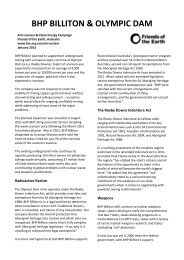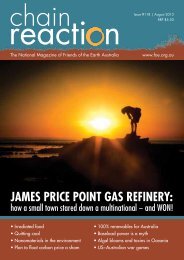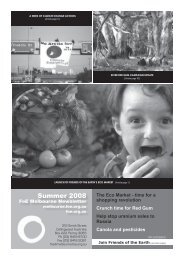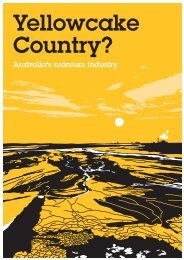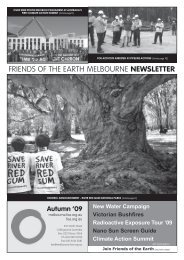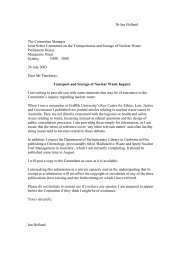Thirty Years of Creative Resistance - Friends of the Earth Australia
Thirty Years of Creative Resistance - Friends of the Earth Australia
Thirty Years of Creative Resistance - Friends of the Earth Australia
You also want an ePaper? Increase the reach of your titles
YUMPU automatically turns print PDFs into web optimized ePapers that Google loves.
Kathleen McCann<br />
In 1996 I was in Jabiru in <strong>the</strong> Nor<strong>the</strong>rn<br />
Territory. A community campaign to stop<br />
fur<strong>the</strong>r uranium mining in Mirrar country<br />
was on <strong>the</strong> rise. Energy Resources <strong>of</strong><br />
<strong>Australia</strong> (ERA) already operated <strong>the</strong><br />
Ranger mine surrounded by Kakadu<br />
National Park and were pushing <strong>the</strong> Mirrar<br />
people to agree to ano<strong>the</strong>r mine on <strong>the</strong>ir<br />
traditional lands at Jabiluka.<br />
O<strong>the</strong>rs in <strong>the</strong> room from FoE, ACF , ECNT<br />
and Gundjehmi were weighing up <strong>the</strong> pros<br />
and cons <strong>of</strong> a non-violent blockade as many<br />
<strong>of</strong> <strong>the</strong> procedural avenues <strong>of</strong> resistance<br />
were nearly exhausted. There was a need<br />
to galvanise <strong>the</strong> various pockets <strong>of</strong> support<br />
to form a collective force, in solidarity with<br />
and led by, <strong>the</strong> Mirrar Traditional Owners.<br />
Throughout my involvement with FoE I<br />
have made banners, cartoons, stickers,<br />
posters and flyers to communicate our<br />
environment and social justice activities<br />
and aspirations. I had especially gravitated<br />
towards <strong>the</strong> anti-uranium cause, believing<br />
it necessary to begin at home to help stop<br />
<strong>the</strong> deadly spin-<strong>of</strong>fs <strong>of</strong> <strong>the</strong> nuclear industry.<br />
It made sense to convince <strong>Australia</strong>ns that<br />
we should not be involved in any part <strong>of</strong><br />
this process. This is where we dig up <strong>the</strong><br />
uranium that ultimately generates nuclear<br />
waste, but by exercising our democratic<br />
rights it is also where we can hope to make<br />
a difference.<br />
Sitting in Jabiru considering <strong>the</strong> images<br />
used before in anti-nuclear campaigns I<br />
thought <strong>of</strong> <strong>the</strong> Smiling Sun that originated<br />
in Europe and was adopted worldwide as<br />
a positive promoter <strong>of</strong> solar technology<br />
and a rejection <strong>of</strong> nuclear energy. Created<br />
in <strong>the</strong> seventies it maintained its cute<br />
“retro” appeal but its real strength was<br />
its collective use by <strong>the</strong> communities who<br />
fought <strong>the</strong> anti-nuclear fight. They had<br />
brought it to life. No one group was seen<br />
...................................................................................................................................................................................................<br />
to claim it once in circulation. The text<br />
encircling <strong>the</strong> graphic changed to suit <strong>the</strong><br />
aspect <strong>of</strong> <strong>the</strong> campaign it promoted and<br />
appeared in many languages.<br />
The graphic for <strong>the</strong> Jabiluka campaign<br />
needed to be simple and unmistakably<br />
reject <strong>the</strong> nuclear threat. It needed<br />
to be easily reproduced – by printers,<br />
campaigners, banner painters and kids. It<br />
needed to relate to <strong>the</strong> Traditional Owners<br />
story and to <strong>the</strong> anti-nuclear tradition. The<br />
colours <strong>of</strong> <strong>the</strong> Aboriginal flag, created by<br />
Harold Thomas in 1971, seemed powerful<br />
and logical, resonating a call for solidarity<br />
with <strong>the</strong> first nations <strong>of</strong> <strong>Australia</strong>. This<br />
choice was bolstered by <strong>the</strong> happy coincidence<br />
that <strong>the</strong> Smiling Sun shared<br />
<strong>the</strong> yellow, red and black and connected<br />
it to our own history in <strong>the</strong> environment<br />
movement. Respecting Harold Thomas’s<br />
pivotal contribution to <strong>the</strong> symbolic<br />
heritage <strong>of</strong> <strong>Australia</strong>, Gundjehmi contacted<br />
him asking permission to build on this<br />
foundation.<br />
That <strong>the</strong> representation <strong>of</strong> a human hand<br />
has universal symbolic power is evident<br />
in <strong>the</strong> earliest mark-making. Aboriginal<br />
hand stencils on <strong>the</strong> rocks <strong>of</strong> Kakadu<br />
are a testament to this, <strong>the</strong>ir unbroken<br />
significance a fact <strong>of</strong> life for <strong>the</strong> Mirrar and<br />
o<strong>the</strong>r Aboriginal people. Contemporary<br />
images <strong>of</strong> hands maintain <strong>the</strong>ir wealth<br />
<strong>of</strong> meanings and ability to communicate<br />
directly and <strong>the</strong> outstretched hand showing<br />
a palm denotes STOP in many cultures.<br />
The idea <strong>of</strong> <strong>the</strong> inherent danger <strong>of</strong> <strong>the</strong><br />
nuclear industry was easily gleaned from<br />
<strong>the</strong>ir own hieroglyphic for hazard, a divided<br />
yellow circle radiating out from a central<br />
core.<br />
I put toge<strong>the</strong>r <strong>the</strong> first version <strong>of</strong> <strong>the</strong> black<br />
handprint impressed upon <strong>the</strong> radiation<br />
symbol in a Jabiru room adjoining <strong>the</strong><br />
blockade discussion and <strong>the</strong> image was<br />
immediately welcomed by those next<br />
door. It worked specifically for <strong>the</strong> Mirrar’s<br />
struggle but its message was universal too<br />
- <strong>of</strong> community resistance and rejection<br />
<strong>of</strong> any nuclear threat: uranium mining,<br />
nuclear reactors, weapons and waste.<br />
Originally <strong>the</strong> FoE Anti-Uranium collective<br />
made simple paper stickers and later<br />
more substantial campaign materials<br />
using <strong>the</strong> hand image and it took <strong>of</strong>f from<br />
<strong>the</strong>re. Requests came from far and wide<br />
to use <strong>the</strong> image in Jabiluka campaign<br />
paraphernalia, web-sites, publications<br />
and fundraising initiatives as <strong>the</strong> blockade<br />
FoE 30 <strong>Years</strong> 68



